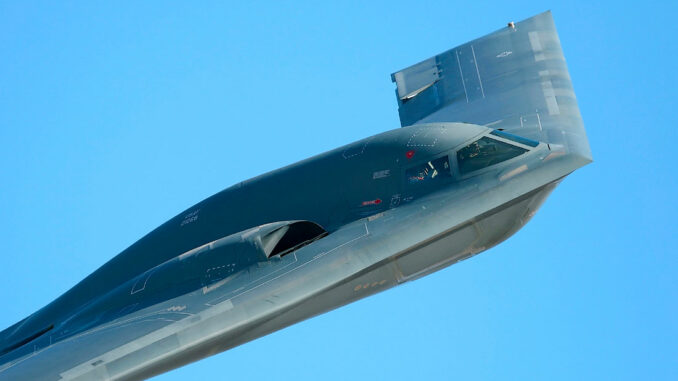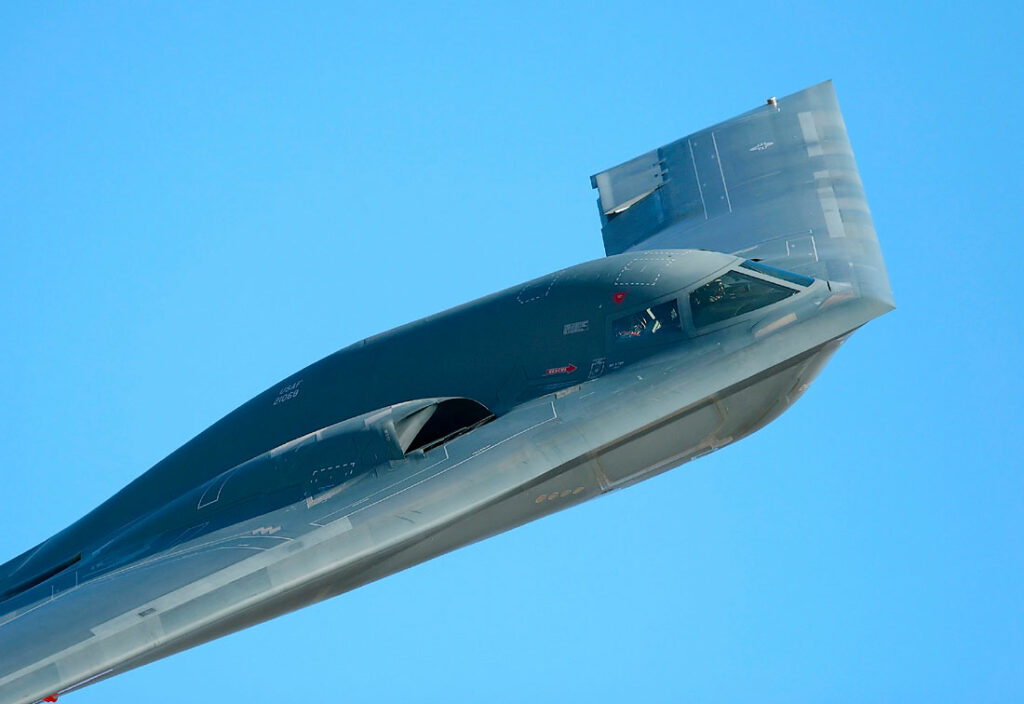
The B-2 Spirit strikes in Yemen send a strong warning to Iran about the U.S. Air Force’s ability to target strategic underground sites.
The B-2 Spirit stealth bomber was recently deployed for a strike in Yemen, targeting underground weapon storage sites controlled by the Houthis. This was the first mission of its kind for the B-2 in several years, and its goal was to send a clear message to Iran, which supports the Houthis. These weapon sites, despite being located in areas with low air defense, required the use of a force capable of striking deeply buried targets, a specialty of the B-2. The strike also coincided with rising tensions between Israel and Iran, adding to the symbolic significance of this military action.
The strategic role of the B-2 Spirit in strikes against the Houthis
The deployment of the B-2 Spirit, a unique stealth aircraft capable of precisely hitting underground targets, was much more than a simple attack on Houthi weapon storage facilities. This mission aimed to send a strategic message to Iran, the Houthis’ ally, by demonstrating the U.S.’s ability to strike deeply buried targets, despite attempts to shield them. The targets, described as “hardened underground weapon storage sites,” show that the U.S. sought to test and demonstrate its capacity to attack installations typically out of reach of conventional bombs.
The choice of the B-2, capable of carrying specialized bombs like the GBU-57 or MOP (Massive Ordnance Penetrator), underscores this bunker destruction capability. This type of weapon, weighing approximately 30,000 lbs (13,600 kg), is designed to penetrate dozens of meters underground before exploding, capable of reaching highly protected targets such as Iran’s nuclear infrastructure. Although it hasn’t been confirmed that this weapon was used in the strike, the mere fact that the B-2 was deployed reinforces the idea of a forceful display aimed at Iran.
The importance of deterrence in a tense geopolitical context
The strike with the B-2 Spirit comes at a time of rising tensions in the Middle East, where Iran and its allies like the Houthis are ramping up their military activities. Choosing to strike underground targets, often perceived as invulnerable, constitutes a clear act of deterrence. The Houthis, designated as international terrorists, have intensified their attacks on civilian and military vessels in strategic areas such as the Red Sea and the Bab el-Mandeb Strait. This ability to threaten global trade and cause environmental disasters is a significant concern for the United States.
The message sent by the B-2 strikes is twofold. On the one hand, they weaken the Houthis’ military capabilities by targeting their infrastructure, but they also send a signal to Iran, reminding them that underground facilities are not immune to American airstrikes. This is especially relevant as Israeli strikes against Iran become increasingly likely. At the same time, the use of such military power on targets with limited defenses highlights the U.S.’s intent to show that, even without direct confrontation, it can project its power anywhere in the world.

The technological and logistical implications of the B-2 strikes
The use of the B-2 Spirit in this operation highlights the importance of advanced technologies in modern conflicts. The penetrating bombs carried by this bomber, such as the GBU-31 JDAM equipped with 2,000-pound (900 kg) penetrator warheads, or the GBU-57, are designed to hit targets deeply buried underground. This allows for the neutralization of storage sites, command centers, or underground military installations—targets that conventional bombs could not reach. Additionally, the B-2 can deploy up to 16 bombs of the 2,000-pound class, allowing for repeated strikes on a target to maximize damage.
These capabilities, however, come at a cost. The B-2 is one of the most expensive aircraft to maintain in the U.S. arsenal, with an estimated flight cost of around €122,000 per hour. Moreover, only 19 of these aircraft exist, making it a precious and limited resource for the United States. Deploying the B-2 in a context where enemy air defense is relatively weak shows that strategic considerations outweigh the operational economy. It serves as a reminder that the U.S. can strike anywhere in the world, with weapons capable of destroying even the most fortified targets.
Economic and geopolitical consequences of the operation
The impact of this strike goes beyond the immediate objective of destroying Houthi infrastructure. From a geopolitical perspective, it represents an act of deterrence toward Iran and its allies. By attacking these sites, the U.S. sends a direct warning: no target is too protected or too remote to escape an American strike. This comes as Iran faces increasing pressure over its nuclear program and the looming threat of Israeli airstrikes. The operation could thus serve as a signal to Tehran, showing that the U.S. is ready to deploy its most powerful conventional capabilities if necessary.
From an economic standpoint, the U.S. engagement in this region is not without cost. In addition to the expenses related to deploying the B-2 and the sophisticated weapons it carries, the entire military operation aimed at protecting freedom of navigation in the Gulf of Aden and the Red Sea requires considerable investment. The global maritime trade passing through these waterways is valued at several billion euros annually. Any disruption in this key region could have destabilizing effects on the global economy, which explains the importance of these military interventions.
A demonstration of force and precision
The B-2 Spirit strikes on Houthi sites demonstrate that the U.S. maintains a clear deterrent posture in a strategically important region of the world. Although it remains unclear whether specialized weapons like the GBU-57 MOP were used, the operation itself serves as a strong reminder of the capabilities of the U.S. military. In a context where tensions between Israel and Iran are reaching critical levels, this strike adds an extra dimension to the American strategy in the Gulf. More than just a military operation, it was meant to send a clear warning to potential adversaries.
War Wings Daily is an independant magazine.